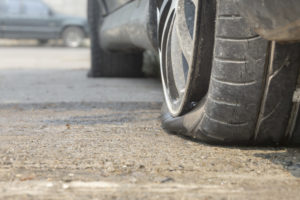 Anyone who has been driving for long enough is going to have to deal with a flat tire at some point in their life. Many people in North America use services, such as AAA, in these types of situations.
Anyone who has been driving for long enough is going to have to deal with a flat tire at some point in their life. Many people in North America use services, such as AAA, in these types of situations.
But what happens if you don’t have access to them when you get a flat? What if help is a few hours away? What are you going to do if your cell phone is dead?
The bottom line is that every person who operates a motor vehicle (and probably everyone else too) should know how to replace a tire. Check out this list and see if you know what to do when you have a flat.
How to Change a Flat Tire: 10 Crucial Steps
Flat tires are a very common occurrence. Here are 10 things you need to know for when you find yourself in this situation.
1. Be Prepared
Knowing how to replace old tires isn’t going to do you any good if you don’t have the proper equipment. You need to be sure you have everything you need to change a tire in your car at all times.
At the very least, you will need a spare tire, a tire iron, and a high-quality car jack that’s compatible with your vehicle. Among other things in your emergency kit (you do have one in your car, right?), you should have a flashlight in case it’s too dark to see.
2. Drive Safely
Always exercise proper caution when driving a motor vehicle. Potholes, nails, rocks, and other things can easily burst your tires.
Be wary of road conditions at all times. In other words, the best way to deal with a flat tire is to never get one in the first place.
Make a habit of checking your tires periodically. This includes measuring the air pressure and inspecting them for damage, nails, or anything else that could cause a problem down the road. You can check the pressure using a tire gauge.
4. Don’t Panic, Park Safely
So you just ran over something in the road and you hear a loud crashing sound. The warning lights immediately go on. This is certainly a startling experience but, as a driver, you’ve got to keep your wits and remain calm.
Pull off to the side of the road if necessary, but stop as quickly as is safely possible.
You will need to a spot with solid ground and no incline. Otherwise, it could be very difficult and/or dangerous to attempt to lift the car. In these situations, you should find help.
5. Loosen the Lug Nuts
Once you’ve got all the equipment out and ready, you are going to want to remember this crucial tip: loosen the lug nuts before you lift the car. Once the tire is lifted, it will be ‘floating’ so to speak, making it close to impossible to remove the lug nuts because the wheel will keep spinning.
It may be hard to imagine it, but once it happens to you and you have to start all over, you will never forget it again.
6. Set the Jack
This is an extremely crucial part of the process that requires caution. You need to place the jack underneath your car. The exact location you place it will depend on which tire is to be changed and the specific vehicle you drive.
Attempting to lift a vehicle with the jack in the wrong place can damage the car or cause it to slip. This can cause serious bodily harm or even death.
The owner’s manual should have clear information on how to change the tire.
7. Lift the Car
Once the jack is securely in place, you can begin to lift the car. Depending on the type of jack, you might have to turn a handle or pump a lever.
Slowly lift the car until the tire to be changed is no longer touching the ground. You should be able to spin the tire with your hands.
8. Remove the Lug Nuts
Now you can simply finish loosening the nuts and remove them. Make sure to keep them close and don’t lose them!
9. Replace Flat Tire
Now you can put the replacement tire on. You might have a spare tire or just a temporary tire (known as a donut). Just line up the holes and push it in.
You can’t drive very far or fast with the donut. Either way, make sure to visit a shop as soon as possible to get the new tires.
10. Lower Vehicle and Tighten The Lug Nuts
Now all you have to do is lower the vehicle, tighten the lug nuts back on, and carefully remove the jack.
You should be good to go, given that the conditions are safe. Again, remember to get a new spare tire in case it happens again.
Don’t Let a Flat Stop You
A flat tire can happen to anyone, but there’s nothing to worry about.
You may be able to call someone one for help, and you may be a member of AAA or something similar. However, it’s best to be independent and know how to deal with a flat tire on your own. You never know when this skill will come in handy in an emergency situation.
Follow the steps listed above and be ready. Visit our website for owner’s manuals and blogs about this and other automotive topics, and feel free to upload your o